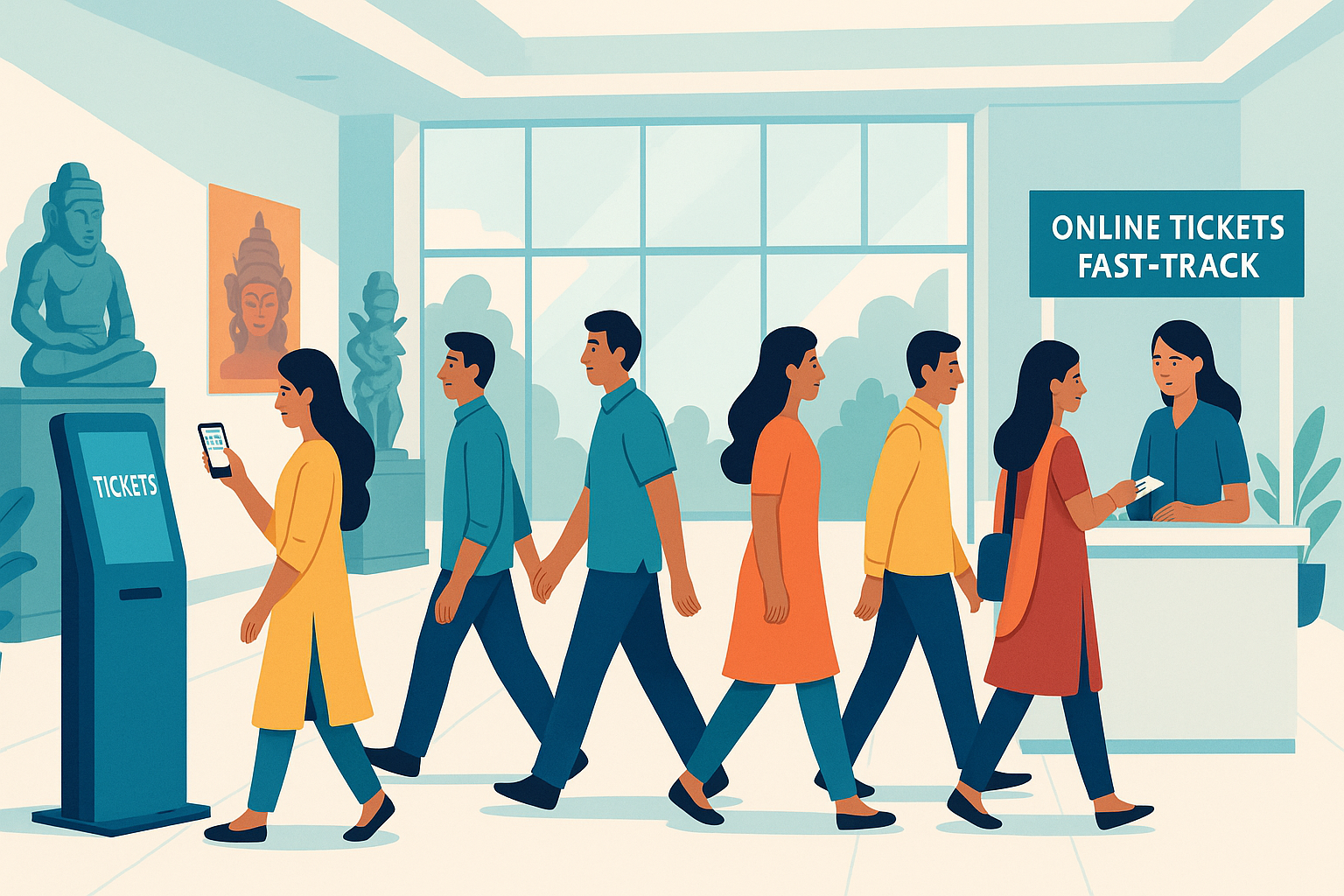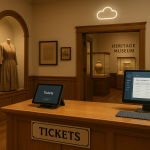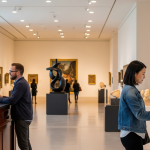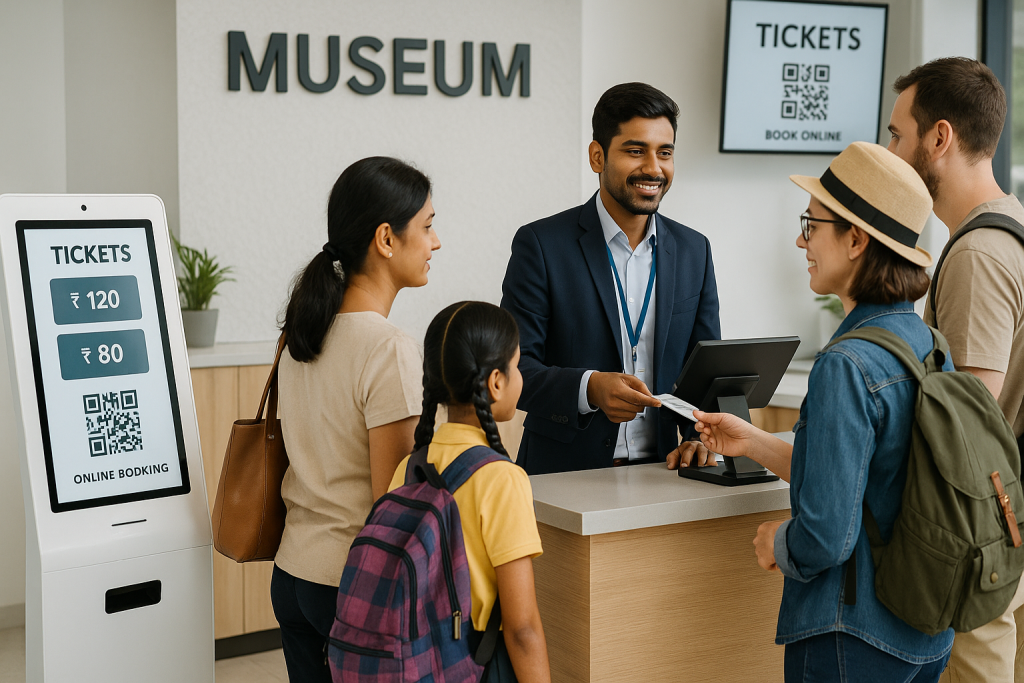Long queues are a common problem in museums. Families wait too long. School groups crowd the counters. Visitors often feel frustrated before they even enter.
A modern museum ticketing system solves this issue. It combines online booking, real-time queue monitoring, and fast counter sales. The result is shorter lines and smoother entry.
Reducing wait times improves the visitor experience. It also helps museums operate more efficiently and earn more revenue. In India, where footfall in cultural venues is rising, digital-first ticketing is no longer optional. It is essential.
What Causes Long Queues in Museums and Cultural Venues?
Long queues don’t happen by accident. They are the result of a few common issues.
First, visitor surges. Holidays, weekends, and school trips bring sudden crowds. Staff cannot keep up with the demand.
Second, manual ticketing. Counters that rely on paper slips or outdated systems are slow. Each step takes extra time.
Third, limited entry control. Without real-time queue monitoring, staff cannot see when lines are building. Visitors keep waiting, unaware of delays.
Finally, disconnected systems. Online sales, walk-ins, and group bookings often run separately. This creates confusion and bottlenecks at the gate.
A modern queue management software can fix these problems. It helps museums cut down delays and keep visitors moving smoothly.
How Does a Museum Ticketing System Help Reduce Queues?
A museum ticketing system reduces waiting by connecting every sales channel. Online booking, counter sales, and entry validation all work together.
Visitors who book online can skip long lines. They arrive with a QR code or mobile ticket that is scanned in seconds.
At the counter, staff use the same system. Walk-ins and group bookings are managed without double entry or confusion.
The system also updates capacity in real time. This prevents overselling and helps spread visitors across the day.
By combining online and counter workflows, the ticketing system removes bottlenecks. Queues get shorter. Entry becomes faster. The overall visitor experience improves.
Which Core Features Improve Ticketing System Efficiency?
Not every system reduces queues. The right features make the difference.
1. Online advance booking
Visitors can buy tickets before arrival. This spreads demand across the day.
2. Timed entry slots
Museums can control how many visitors enter at once. Crowds are balanced.
3. QR and barcode scanning
Tickets are verified in seconds. No manual checks, no paper slips.
4. Real-time queue monitoring
Staff see live data on waiting times. They can redirect visitors or open more counters.
5. Mobile tickets and kiosks
Self-service kiosks and mobile passes reduce pressure on staff counters.
Together, these features make a museum ticketing system efficient. Queues shrink. The visitor experience improves.
How Do Online Sales and Counter Sales Work Together?
Many visitors now book tickets online. But walk-ins still form a big share in India. A good museum ticketing system connects both channels.
When online and counter sales run on the same platform, inventory stays updated. Staff see the same data as online buyers. This avoids overbooking and confusion.
Group bookings can also be managed easily. Schools or tour operators reserve slots online, while staff handle walk-ins at the counter without delays.
By linking online and offline sales, museums create a smooth flow. Visitors spend less time waiting. Staff work with less stress. Queues move faster.
What Role Does Real-Time Queue Monitoring Play in Visitor Experience?
Real-time data changes how queues are managed. A museum ticketing system with live monitoring shows staff exactly where delays are building.
Dashboards display the number of visitors waiting. Alerts can notify staff when lines grow too long.
With this insight, managers can open more counters, guide visitors to self-service kiosks, or adjust timed entry slots.
For visitors, the benefit is simple. Less waiting. More time enjoying exhibits.
Real-time queue management software not only reduces frustration. It also builds trust that the museum values a smooth visitor experience.
How Does Reducing Queueing Improve the Overall Visitor Experience?
Visitors come to enjoy the exhibits, not to stand in line. Shorter queues mean more time inside the museum.
Families with children feel less stressed. Tourists can manage their schedules better. School groups move smoothly without crowding entrances.
A fast entry also creates a positive first impression. Visitors start their journey in a relaxed mood, ready to explore.
For the museum, the impact is clear. Better reviews, stronger word-of-mouth, and higher chances of repeat visits.
Reducing queues is not only about efficiency. It is about giving every visitor a welcoming, memorable experience.
Why is Queue Management Software Important for Indian Museums?
Indian museums are seeing larger and more diverse audiences. Festivals, school trips, and tourist seasons bring heavy footfall. Long lines are common.
Many institutions still rely on manual ticketing. Paper slips and basic counters cannot handle peak demand. Visitors lose patience, and staff feel overwhelmed.
Queue management software offers a simple fix. Real-time monitoring, QR scanning, and timed entry help spread visitors evenly.
For India’s cultural sector, the benefit goes beyond convenience. Digital systems align with the country’s push for smart infrastructure and better visitor services.
Adopting a modern museum ticketing system helps Indian museums stay relevant and visitor-friendly in a digital age.
What Should Museums Look for in a Ticketing System in India?
Not all systems solve the queue problem. Museums need to choose the right features.
Here’s a quick checklist:
- Cloud-based and mobile-first – easy to set up and access anywhere.
- Integrated online and counter sales – one system for all channels.
- QR and barcode scanning – instant ticket validation.
- Timed entry and capacity control – balance visitor flow.
- Real-time queue monitoring – staff know when to act.
- Scalable and affordable – fits both large museums and smaller cultural spaces.
A museum ticketing system with these features ensures smooth entry. It also prepares museums for future digital growth.
How Does EveryTicket Solve Queueing Challenges for Museums?
EveryTicket is designed only for Indian museums. It is built around the real problems cultural institutions in India face every day.
Visitors can book tickets online and get a QR code. At the entrance, scanning takes just a second. Families and school groups spend less time in line and more time inside.
For walk-ins, EveryTicket’s POS system supports fast counter sales. Inventory updates instantly, so online and offline bookings never clash.
Timed entry slots and real-time queue monitoring give museum staff better control. If crowds build, managers can act quickly to prevent long queues.
EveryTicket is lightweight, cloud-based, and affordable. That makes it easy for Indian museums, big or small to adopt without heavy infrastructure.
With EveryTicket, queues shorten. Visitor satisfaction improves. Museums gain a reliable digital system made for them.
Wrap-up!
Queues are one of the biggest barriers to a smooth museum visit. Long lines frustrate visitors, slow down staff, and reduce overall efficiency. A modern museum ticketing system changes that. With online booking, timed entry, QR scanning, and real-time queue monitoring, museums can welcome more visitors without the wait.
For Indian museums, the need is urgent. Growing footfall and rising expectations mean digital systems are no longer optional. They are essential for creating a better visitor experience.
EveryTicket is built for this. It helps Indian museums cut queues, improve efficiency, and delight visitors from the moment they arrive.
Ready to reduce queues at your museum? Fill the Inquiry form and book a free demo with us.



